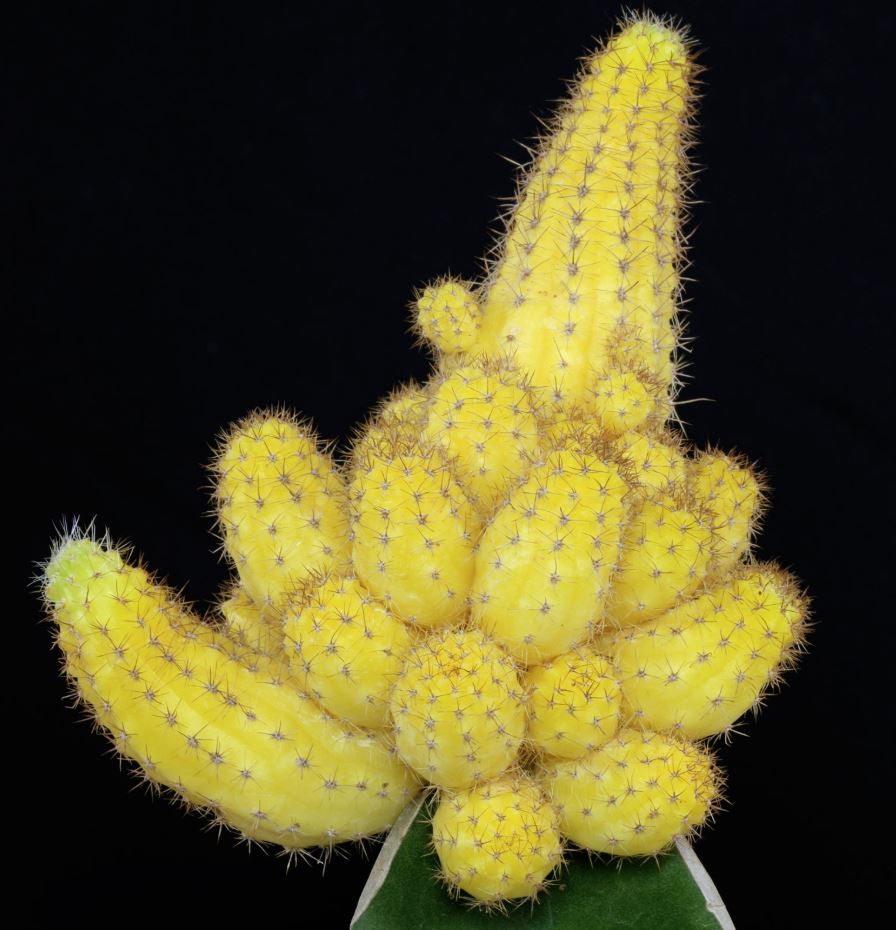Echinopsis chamaecereus, which is famously known as Peanut Cactus, has its origin from mountainous regions of Argentina. It is described as a mat-forming cactus which has finger-like stems which could grow to a height of 6 inches and broaden to 12 inches.
It is famous for its unique finger-like structures that are aesthetically enhanced by beautiful scarlet flowers. Apparently, Echinopsis chamaecereus genesis was from a self-incompatible clone.
Due to its reduced genetic diversity, it inhibits the formation of cultivars through selective breeding techniques. These plants are found in places like B&Q grafted onto plain thick green cacti for dependency and come in some very bright and attractive colours
Description of the peanut cactus
Echinopsis chamaecereus got its other name Peanut Cactus, from its close resemblance to the peanut plants. As the plant grows more and more the cactus length shoots and the stems develop finger-like shapes that are pale green.
These structures also form soft surfaces that are segmented to low ribs with shallow ridges in between. The cactus also has main stems that lay near to the potting that mostly have a 0.8-inch diameter and a length of up to 6 inches.
These main stems hold a number of branches which could multiply with a few years. The areoles which are closely spaced are well endowed with whitish spines that range from 10 to 15.
The areoles also facilitate the growth of the bright scarlet flowers which assume the shape of a cup and would grow up to a width of 2.5cm. During the early summer, the flowers, unfortunately, last for about 24 hours. However, the flowering process continues for up to utmost three weeks.
The blooms will grow a lot from early spring to early summer in the presence of ideal conditions.
If you do not like the sound of a peanut cactus then check out these succulents representative species.

Peanut cactus has a yellow-flowered form and a form that lacks chlorophyll (Echinopsis chamaecereus var. lutea) and has to be grafted onto a green root-stock to survive like the picture above.
What are the ideal conditions for Echinopsis chamaecereus?
Watering
It’s advised to water the Echinopsis chamaecereus moderately during the active rest periods. The frequency of watering the plant should be infrequent but ensure the potting is well moist. Allow the water to dry up to the top centimeter before you water the plant again.
During winter when it’s cool, the plant could be left out to grow until the season is over. When introduced to higher temperatures, the water intake will gradually rise, and watering will be required to prevent the complete drying of the soil.
Houseplant care.
Peanut Cactus is an ideal plant to have at your home since it’s easy to manage and grow. The plants only demand the usual plant growing conditions for it to blossom. It also doesn’t require any special treatment so long as the conditions indoor are favorable.
Temperatures.
In its active growth periods, the normal room temperature is ideal for the Echinopsis chamaecereus growth. Due to its easy adabtibility to certain harsh conditions it can survive in the low freezing temperatures. It can also thrive in temperatures of about 7 degrees during winter.
Lighting.
As with many plants, the Echinopsis chamaecereus needs direct sunlight to facilitate different processes for a healthy cactus. Depriving it of sunlight will have a negative effect on its growth where it develops thin, fragile, and elongated shoots. Position the plant close to a window that allows most of the sunlight in the room.
Gardening
It would be a wonderful inclusion in your flower garden due to its unique traits and appearance. It does well in the outdoors since it has a better adaptation to harsh temperatures that may be as low as -7 degrees Celcius. Provide cool rest conditions during winter for better blossoming. The ideal landscape will be a rocky one to help in water absorption. It may take some time to spot the flowers, but during Spring the cactus will catch everybody’s attention.
Feeding
To facilitate proper growth alongside ideal conditions, always introduce fertilizer, and thoroughly mix it with the soil in the potting. The fertilizer introduces valuable nutrients and minerals which facilitate healthy growth. In cases of repotting introduce the fertilizer soil mixture in the new potting for sustainable growth. The fertilizer should be added occasionally, which should be low in Nitrogen. You should also work with fertilizers that are enriched with minerals such as phosphorus and potassium.
Potting and repotting
You need to include a good soil composition which could also be peat based potting. The composition should also comprise of course sand which facilitates better drainage to avoid clogging. A wonderful trait of the Peanut cactus is the fact that it has a shallow root system that spreads. It would be better to use a wider container that is 3 inches deep to provide enough space for the roots to stretch. During Spring you could repot your plant if at all its crowded. Move it into a larger container or break the plant and replant each in their own container.
Irrigation.
It is basically watering the plant, which should have a controlled way to ensure healthy growth. Echinopsis chamaecereus needs deep watering after a fortnight during the Spring and Summer seasons. You should allow the plant to rest during winter when there’s limited activity. Avoid watering it and give it enough space and time so long as the soil isn’t completely dry. The Peanut cactus thrives well in dry conditions it would be wise to imitate a similar growth scenario.
Positioning.
The cactus needs direct sunlight which should be regulated to prevent burns. The ideal positioning of the Echinopsis chamaecereus species is full direct exposure during cool seasons and controlled lighting during summer. The sunlight is necessary since it facilitates better flowering and blossoming during Spring to mid Summer.
Propagation.
This process is ideal for the Echinopsis chamaecereus since it doesn’t produce seeds which could be used to grow young plants. A mature plant is propagated into cuttings which are re-potted to give life to another set of the plant. The process is fairly simple since it involves extracting a branch from the main stem. Ensure that you simulate the same potting contents as in the parent’s flower pot and fix the detached part in a horizontal position. You could also work with a larger space that has the ability to hold more plants in the potting mixture.




Leave a Reply